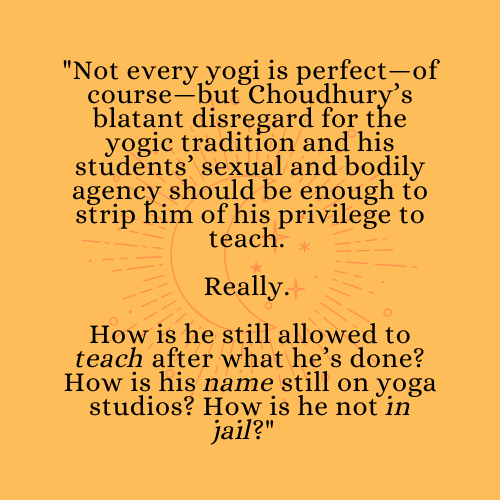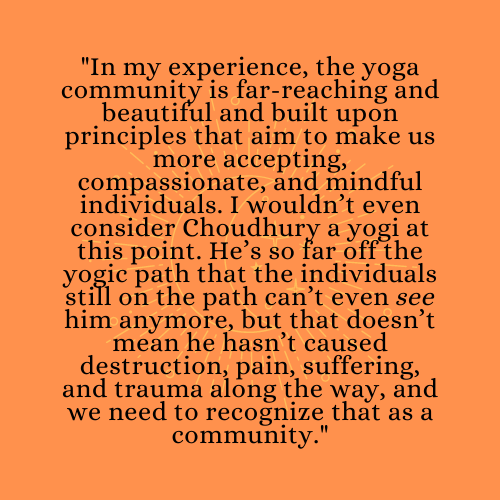Who is Bikram Choudhury?
If you’ve been practicing yoga for some time—or you’re a frequent Netflix and chill-er—then it’s quite possible that you’ve already heard of Bikram Choudhury and perhaps even watched the Netflix documentary detailing his life and misconducts, Bikram: Yogi, Guru, Predator (2019). If you’ve never heard of him, let me tell you all you need to know, though I’m sure the title of the Netflix documentary says it all: Choudhury is a yogi known for popularizing hot yoga in the western world (you might be familiar with Bikram yoga?), as well as raping, sexually abusing, discriminating against, and harassing a number of his students during his infamous yoga teacher trainings beginning in the 1990s and continuing through to present day.
In the Netflix documentary—it’s a really eye-opening but infuriating watch if you’re interested—we see Choudhury leading yoga teacher trainings in the United States wearing nothing but a speedo; we see clips of Choudhury verbally abusing students by making harsh comments about their weight and appearance; we see Choudhury forcing students into postures and even standing on their backs or hip bones while doing so; and we have the opportunity to hear from a few of the students he victimized in the past including Larissa Anderson and Sarah Baughn who both share their horrific experiences of Choudhury’s predacious and trauma-inducing behaviours.
The stories shared in the documentary are absolutely terrifying, heartbreaking, and soul-crushing, especially for women who are seriously considering taking a yoga teacher training. Choudhury’s abuse went on for decades before he was penalized for his atrocious actions, so it’s understandable that women might be wary of taking a yoga teacher training when there are threats like him in the field. For instance, another yogi who has been accused repeatedly of sexually assaulting and harassing his students was K. Pattabhi Jois, a yogi widely regarded for his involvement with the popularization of Ashtanga yoga.
After the sexual assault and rape allegations were made against Choudhury, he fled the United States and returned to India. The scariest part of Choudhury’s story is that it’s not over yet: he’s still opening studios in India and holding teacher trainings. Indeed, Choudhury continues to have a strange cult following despite the fact that he is a recognized sexual predator.
And that’s a problem.
Choudhury’s Violation of the Yamas and Bodily Agency
The Yamas—the moral principles that guide the way we interact with the world, our environment, ourselves, and the individuals surrounding us—are the first pillar of the Eight Limbs of Yoga, and there are five Yamas in total. In Sanskrit, the Yamas are Ahimsa, Satya, Asteya, Brahmacharya, and Aparigraha which translate, respectively, to non-violence, truth, non-stealing, celibacy or precise distribution of energy, and non-hoarding.

Choudhury has violated all five Yamas throughout his teaching career: he was sexually and verbally violent toward students (a violation of Ahimsa); he still has not taken responsibility for his predatory and harmful behaviours (a violation of Satya); he stole bodily agency and dignity from many of his students (a violation of Asteya); he used his power to perform acts of sexual deviancy rather than acts of kindness or compassion (a violation of Brahmacharya); and he exploited the yoga asanas (or postures) for his own financial and material gain to an excessive extent (a violation of Aparigraha).
Not every yogi is perfect—of course—but Choudhury’s blatant disregard for the yogic tradition and his students’ sexual and bodily agency should be enough to strip him of his privilege to teach.
Really.
How is he still allowed to teach after what he’s done? How is his name still on yoga studios? How is he not in jail?
A Light at the End of the Tunnel
When I first found out about Choudhury’s heinous crimes—which was about a year or so ago now—I was distraught. I couldn’t believe that something so morally and spiritually wrong could be going on in the yoga community for so many years behind closed doors. My heart goes out to those women who suffered beneath his hand, and I can’t even begin to imagine how his actions affected their relationships with themselves, their bodies, their agency, and their yoga practice.
Luckily, there is a large group of yogis and teachers who no longer support Choudhury and refuse to associate with him and his practice. In fact, there are many studios that trashed their Bikram yoga classification and opted for the more generic hot yoga classification instead.
There are, unfortunately, still some individuals taking trainings with Choudhury, which is problematic and—to be quite honest—dangerous. Teachers like Choudhury are a rarity in the yoga community, but they do exist (as with most occupations in life). This being said, it’s important to let a teacher know if they are making you physically uncomfortable. Just because they are a teacher does not mean that you cannot confront them if they make you feel uncomfortable: a teacher should never have control over your bodily and sexual agency, and Anderson and Baughn make this clear when they hold Choudhury accountable for his actions in the Netflix documentary.
It’s not my intention to deter anyone from taking a yoga teacher training.

I’ve had an exceptional experience in my yoga teacher training these past four months and I’m grateful that I get to work with some of the most supportive, inspiring, and accepting yogis in the field. I’ve had nothing but positive experiences and I’d encourage any individual considering taking a yoga teacher training to seek out a studio and instructors with whom they are comfortable.
In my experience, the yoga community is far-reaching and beautiful and built upon principles that aim to make us more accepting, compassionate, and mindful individuals. I wouldn’t even consider Choudhury a yogi at this point. He’s so far off the yogic path that the individuals still on the path can’t even see him anymore, but that doesn’t mean he hasn’t caused destruction, pain, suffering, and trauma along the way, and we need to recognize that as a community.